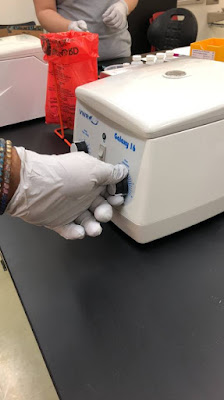During this lab, we really went into depth on using micro-pipettes. From my last post, I had never touched a micro-pipette, let alone know how to use one. There are 4 micro-pipettes that we use, P-20, P-100, P-200, P-1000. Their names correspond with the maximum volume they can hold. When using a micro-pipette, you do not want to push all the way down when collecting a sample, or else it will pick up its maximum volume. Push down to pick up the sample, then slowly lift your finger from the button to retrieve. The P-1000 is equivalent to 1 mL and it takes the big tips while the other three pipettes take the small tips. I learned a lot about these pipettes, but I think one of the most important pieces I learned was to always distribute the larger volume of your sample first, then mix your smaller volume in.



